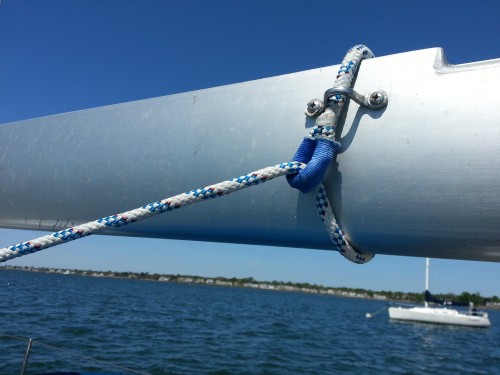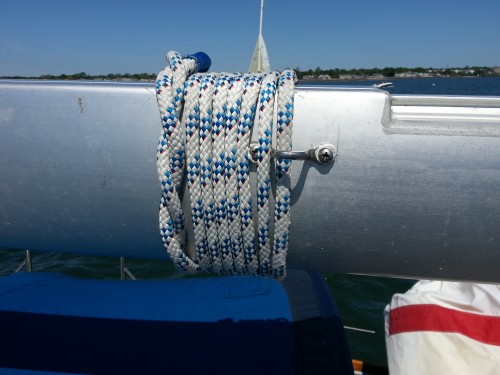Do you want to be informed on new Posts on this Thread? (members only)
| Sail & Rigging - Preventer for Main |
|---|
|
Join Date: 15 April 2011
Posts: 396 |
||
|---|---|---|
|
Preventer for Main Dear All, Although my sailing season may not begin until next year...I can still dream! I am wondering about how you all set up preventers. I am inclined to attach a nylon line, one port and one starboard, to the boom end, run forward to a turning block as far forward as I have (not really sure where that is) and then back to the cockpit. In a race to Bermuda we had the bad experience of racing down a large wave on a broad reach, first rolling, then yawing and then the preventer, which was attached to a bale on the boom, broke. This was aboard a Tartan 41, another S&S design. The force of the gybe snapped the gooseneck - by the grace of God, no one was injured. That was not the case for crew on other boats, unfortunately. So, I would like to plan a better solution. Fair Winds, Chris |
|
Join Date: 10 April 2010
Posts: 32 |
||
|---|---|---|
|
Hello Chris, You raise a good question, and one that we have considered for our sailing on Anthea (41/1979). Our solution is to use a boom brake, rather than a preventer. We use the Weichard boom brake and have been very happy with it, though there are other good boom brakes on the market, too. We use the boom brake to facilitiate jibes in heavier air and seas. And in the event of an uncontrolled jibe, the brake will slowly allow the boom to cover over to leeward in a (hopefully) controlled manner. The problem with fixed preventers is how to release them with the main backwinded; often something breaks before they can be carefully/safely released. We have found Nigel Calder's discussions of preventers and brakes quite informative. Good luck! Mark (s/v Anthea)
|
|
Join Date: 02 January 2008
Posts: 1547 |
||
|---|---|---|
|
Dear Chris
|
|
Join Date: 15 April 2011
Posts: 396 |
||
|---|---|---|
|
Dear Mark, Thank you. I watched a couple of videos of the brake in action but they don't show, as one would expect due to difficulty of filming, any rough-sea conditions. Are you confident that it would suffice in severe weather? Of would you consider another methodology under those conditions? Fair winds Chris |
|
Join Date: 15 April 2011
Posts: 396 |
||
|---|---|---|
|
Dear Lars, Thank you. I see the value in your set-up. Where on the boom would you attache the preventer? The foreguy/sheets currently do not come to the cockpit but I think it wise to move the winches used for the spinnaker to a position behind the primary winches. To do this, some sort of support will need to be fabricated so that they sit above the cockpit coaming. Turning blocks may also need to added. Currently, I do not have Navtec hydraulic vang/back stay adjuster, but am familiar with it from a previous boat i owned. This is one more decision to make at some point bust since I am most inclined to cruise and not race, I don't know that I will spend the money on this equipment. I will say, however, that these devices were quite useful. With warm regards, Chris
|
|
Join Date: 02 January 2008
Posts: 1547 |
||
|---|---|---|
|
Dear Chris
|
|
Join Date: 10 April 2010
Posts: 32 |
||
|---|---|---|
|
Dear Chris, Good question about the boom brake in severe weather. I guess the answer depends on how severe the weather is and how reefed down the main is. The brake has worked fine for us when jibing in 35 knots with a double-reefed main. The Weichard brake tension can be adjusted depending on how one runs the line through the device. So long as we reef when necessary, we think the brake should work fine in heavier winds. Hope that helps. Regards, Mark
|
|
Join Date: 25 July 2012
Posts: 30 |
||
|---|---|---|
|
Hi I go along with Mark (ANTHEA) on the boom brake system. We have had a Boom Walder for maybe 30 years now and have always been in control of accidental jibes (is that possible?) We have each end of the line that passes through the brake on a winch, one either side of the cockpit. We have this line pretty tight as it keeps the boom down. Sometimes when the sail is back-winded the boom will not go over to the leeward side because the line is tight, but by easing either end of the line from its winch the boom will go over in a controlled manner. (By having the line not so tight the boom will go over as soon as the jibe occurs.) Be sure to have the attachment points for the blocks on deck STRONG – there is a lot of load there, especially the shock load. We are not in favour of having unnecessary lines crossing the foredeck and anyway, coming back from the stem they chafe on or get caught on dorades etc. Its just our choice. David 43/12 |
|
Join Date: 05 August 2010
Posts: 167 |
||
|---|---|---|
|
Hi all,
Best, Martin
|
|
Join Date: 05 August 2010
Posts: 167 |
||
|---|---|---|
|
Dear all,
Preventers, forward view Preventers, winch on cockpit coaming |
|
Join Date: 15 April 2011
Posts: 396 |
||
|---|---|---|
|
Dear Lars, Sorry for the delay in my reply; I have been traveling. Is there a preferred method of attachment? I assume that something that goes around the boom and not, for example, an eye strap, is better. With warm regards, Chris |
|
Join Date: 15 April 2011
Posts: 396 |
||
|---|---|---|
|
Dear Mark, Yes, it does help and thank you. I am concerned about conditions that I have experienced or about which I have read; e.g., 35 knots sustained over a long period of time, possibly days, so that the seas have built to substantial levels. Under these conditions, racing done the face of the wave, especially in our narrow-stern boats, promotes yawing and rolling, the combination of which can produce unexpected jibes. However, you make an excellent point about the size of the main. I found with my Tartan 41, unless racing, that the boat sailed better with a reefed main on all points when the wind got over 18 knots. At 35 knots, I would typically sail well with a triple reef. With warm regards, Chris |
|
Join Date: 15 April 2011
Posts: 396 |
||
|---|---|---|
|
Dear David, Thank you. I appreciate your taking the time to describe the set-up and I can only agree about your comment to take care that the line runs to a very secure deck fitting or winch. The load, under an accidental jibe, is exceptional. I plan to do some more research about this and your comments will help. As an additional note, one of my concerns about this issue arose after thinking about the weight of the boom. I have the original and it is really heavy! With warm regards, Chris |
|
Join Date: 15 April 2011
Posts: 396 |
||
|---|---|---|
|
Dear Martin, Thank you for your thoughtful reply. I agree, having made the error many times, reefing too late, no preventer; etc.; that a permanent set-up makes the use of a preventer much more likely. In the past I have sailed single-handed a lot, although I hope that my sons will take up some of the slack now, and would like to be prepared for bad circumstances, not reactive. Like you and others, I am torn between keeping the deck clear and clean and having a solution that works all the time. With warm regards, Chris Mabels's Casse Tete 43/003 |
|
Join Date: 02 January 2008
Posts: 1547 |
||
|---|---|---|
|
Dear Chris
|
|
Join Date: 15 April 2011
Posts: 396 |
||
|---|---|---|
|
Dear Lars,
|
|
Join Date: 02 January 2008
Posts: 1547 |
||
|---|---|---|
|
Dear Chris
|
|
Join Date: 20 February 2007
Posts: 119 |
||
|---|---|---|
|
Chris:
 Preventer line attached at boom  Preventer line attached at boom  Preventer line stowed on boom. |
|
Join Date: 15 April 2011
Posts: 396 |
||
|---|---|---|
|
Dear Hiro,
|
- Threads : 1730
- Posts : 10339
- Members: 832
- Online Members: 3

